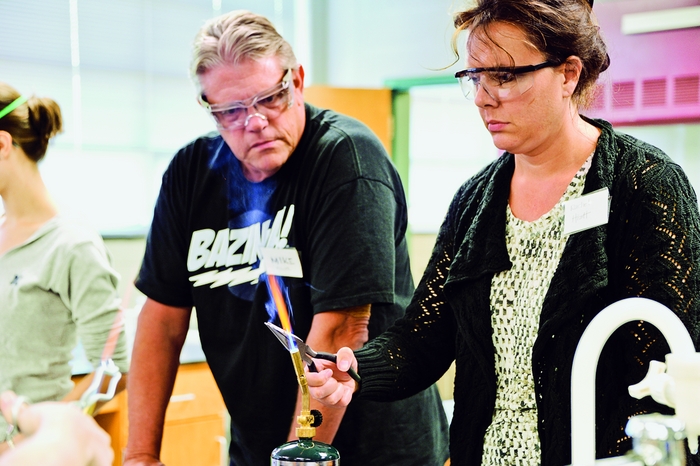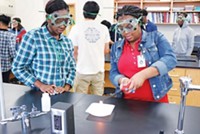Advertisement
Grab your lab coat. Let's get started
Welcome!
Welcome!
Create an account below to get 6 C&EN articles per month, receive newsletters and more - all free.
It seems this is your first time logging in online. Please enter the following information to continue.
As an ACS member you automatically get access to this site. All we need is few more details to create your reading experience.
Not you? Sign in with a different account.
Not you? Sign in with a different account.
ERROR 1
ERROR 1
ERROR 2
ERROR 2
ERROR 2
ERROR 2
ERROR 2
Password and Confirm password must match.
If you have an ACS member number, please enter it here so we can link this account to your membership. (optional)
ERROR 2
ACS values your privacy. By submitting your information, you are gaining access to C&EN and subscribing to our weekly newsletter. We use the information you provide to make your reading experience better, and we will never sell your data to third party members.
Education
Training Camp For Science Teachers
Hands-on materials science program helps educators engage students
by Mitch Jacoby
May 27, 2013
| A version of this story appeared in
Volume 91, Issue 21

\

\
At a science teachers camp in Indianapolis, participants pick up teaching tips on crystal growth (top) and metals and alloys (bottom).
To improve their game and stay in top physical shape, baseball and football players flock to spring and summer training camps for rigorous practices led by specialty coaches. Physical science teachers at secondary schools can also practice their game during the off-season by attending an ASM Materials Camp for teachers. The camps aren’t likely to draw TV crews or adoring fans jockeying for photos and autographs. But they do attract enthusiastic participants who come to hone their science-teaching skills and energetic instructors who make the process educational, rewarding, and fun.
“We’re trying to help teachers develop new tools, tricks, and hands-on techniques for teaching basic materials science in ways that will engage their students and make them curious about science,” says Charles Hayes, executive director of the ASM Materials Education Foundation (ASM-MEF). For the U.S. to stay competitive in science and engineering, Hayes asserts, “we need to get youngsters interested and excited about these subjects.” Helping educators step up their science-teaching game with interesting and thought-provoking demonstrations that are safe and inexpensive is a key step in that process.
ASM-MEF is the education arm of ASM International, a northeastern Ohio-based global organization of some 36,000 members that focuses on serving the materials science and engineering profession. The education arm, which was founded in the 1950s to promote science and engineering education among young students, began organizing and hosting educational workshops for teachers in 2002.
The curriculum at these five-day camps, which are held at locations around the country during the summer and are offered at no cost to teachers, “is like Materials Science 101 at the high school level,” Hayes says. ASM discovered years ago that a substantial fraction of teachers knew little about the properties of solids and consequently underemphasized that subject in their teaching. “Yet solids make up so much of the stuff around us and are critically important to many areas of technology,” Hayes says.
For that reason, the teachers camps involve participants in several days of hands-on activities with solid materials. The educational units include numerous demonstrations on metals, ceramics, glass, polymers, and composites. Experienced instructors, who are also classroom teachers, guide the less experienced teachers through the activities in a step-by-step manner, pointing out potential safety issues and discussing common student questions along the way.
Rebecca Heckman, a 24-year science-teaching veteran who chairs the science department at Princeton High School in Cincinnati, is one of those experienced instructors. C&EN caught up with Heckman at a camp she cotaught last summer in Indianapolis with Princeton colleague Lonnie Dusch.
“My goal is to spark enthusiasm in the teachers so they can go home and impart that enthusiasm to the students in their classrooms,” Heckman said. “Spark enthusiasm” is an understatement. Brimming with contagious excitement, Heckman and Dusch noticeably energized participants with lessons on melting point, solubility, crystallization, redox reactions, metallurgy, and many other topics.
ASM’s data show that of the roughly 4,000 “graduates” over the past 10 years, about 60% of whom teach high school chemistry, more than 80% incorporate some of the camp activities into their teaching.
Marilyn Weiss, who teaches Advanced Placement and other chemistry classes at Park Tudor Upper School in Indianapolis, says she includes many of the lessons she learned at the camp last summer. Examples include exercises on metal plating and electrochemistry, as well as experiments on the properties of metals and alloys and physical differences between two polymers.
In addition to picking up valuable teaching techniques, Tracy Schloemer, a 10th-grade chemistry teacher at Denver School of Science & Technology, says she made great contacts at the camp last summer. “As a teacher, I find networking can be tough. The ASM camp enabled me to meet a diverse crowd of teachers and academic faculty.” Schloemer gives the camp a thumbs-up and is quick to recommend it to colleagues. “It’s free, and you get plenty of stuff to use in the classroom. Why wouldn’t you want to go?”



Join the conversation
Contact the reporter
Submit a Letter to the Editor for publication
Engage with us on Twitter